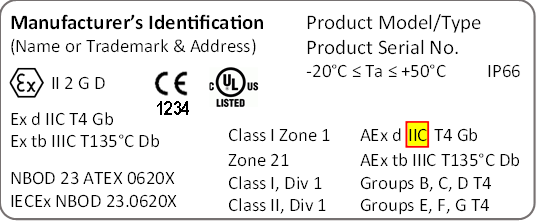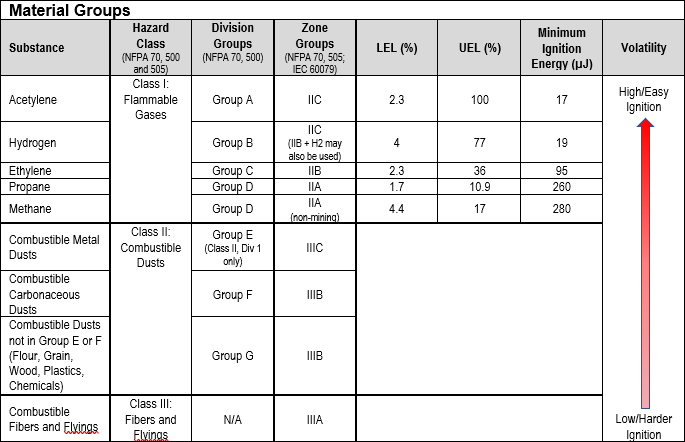The Drill Down, Issue #25: Hazardous Location Electrical Markings - Material Groups
 Introduction
Introduction
This edition on Hazardous Location (HazLoc) electrical equipment markings discusses the material groups used by National Fire Protection Association (NFPA) 70 (National Electric Code (NEC)) and the International Electrotechnical Commission (IEC) 60079-series.
Material groups (e.g. gas groups in the context of this Drill Down) are based on the volatility of the substance, ease of ignition, and location of the substance. Many of you are familiar with the flammability range of gases, as bound by the lower and upper explosive limits (LEL and UEL, respectively), where the concentrations of a substance mixed with air can support combustion. Within that range is a concentration of the substance that ignites most easily. The ignition energy required to ignite this concentration is known as the minimum ignition energy, which is a key indicator of volatility and helps to differentiate substances into their material groups.
NFPA 70, Article 500
The material groups in Article 500 utilize an alphabetic designation for the groups (NFPA 70 (2017) 500.6). Groups A through D apply to Class I locations (i.e., flammable vapors) and Groups E through G apply to Class II locations (i.e., combustible dusts) (see figure 1).
 |
| Figure 1: Equipment label with NFPA 70, Article 500 material groups indicated |
Group A is for acetylene.
Group B is for flammable gas, flammable liquid-produced vapor, or combustible liquid-produced vapor mixed with air that may burn or explode, having either a maximum experimental safe gap (MESG)[1] value less than or equal to 0.45 mm or a minimum igniting current (MIC) ratio[2] less than or equal to 0.40.
Group C is for flammable gas, flammable liquid-produced vapor, or combustible liquid-produced vapor mixed with air that may burn or explode, having either a MESG value greater that 0.45 mm and less than or equal to 0.75 mm, or a MIC ratio greater than 0.40 and less than or equal to 0.80.
Group D is for flammable gas, flammable liquid-produced vapor, or combustible liquid-produced vapor mixed with air that may burn or explode, having either a MESG value greater than 0.75 mm or a MIC ratio greater than 0.80.
Groups E, F and G are for atmospheres containing combustible metal dusts, combustible carbonaceous dusts and combustible dusts not included in Groups E or F (including flour, grain, wood, plastic, and chemicals), respectively.
This Drill Down focuses on Groups A through D for gases, but the combustible dust groups could apply to certain areas on units or vessels subject to USCG oversight.
NFPA 70, Article 505
The material groups under Article 505 utilize a Roman numeral and alphabetic designation for the different groups (NFPA 70 (2017) 505.6) (see figure 2).
 |
| Figure 2: Equipment label with NFPA 70, Article 505 material groups indicated |
Group I is “intended for use in describing atmospheres that contain firedamp (a mixture of gases, composed mostly of methane, found underground, usually in mines)” and is not covered by this standard or Drill Down.
Group II is subdivided into Groups IIC, IIB, and IIA, according to the nature of the gas or vapor. Note that older equipment may be marked without a subdivision for some types of protection, as permitted by marking requirements of prior editions of the standard (NFPA 70 (2017), 505.6). Protection techniques will be discussed in Drill Down #26).
Group IIC is for atmospheres containing acetylene, hydrogen, or flammable gas, flammable liquid-produced vapor, or combustible liquid-produced vapor mixed with air that may burn or explode, having either a MESG value less than or equal to 0.50 mm or MIC ratio less than or equal to 0.45.
Group IIC is equivalent to a combination of Class I, Groups A and B under Article 500.6.
Group IIB is for atmospheres containing acetaldehyde ethylene, or flammable gas, flammable liquid-produced vapor, or combustible liquid-produced vapor mixed with air that may burn or explode, having either MESG values greater than 0.50 mm and less than or equal to 0.90 mm or MIC ratio greater than 0.45 and less than or equal to 0.80.
Group IIB is equivalent to Class I, Group C under Article 500.6.
Group IIA is for atmospheres containing acetone, ammonia, ethyl alcohol, gasoline, methane, propane, or flammable gas, flammable liquid-produced vapor, or combustible liquid-produced vapor mixed with air that may burn or explode, having a MESG value greater than 0.90 mm or MIC ratio greater than 0.80.
Group IIA is equivalent to Class I, Group D under Article 500.6.
Group III relates to combustible dusts or ignitable fibers/flyings and similar to Group II, is subdivided into Groups IIIC, IIIB and IIIA. Group III is addressed under NFPA 70, Article 506 and is not incorporated by reference through 46 CFR Subchapter J, nor addressed by this Drill Down. This group is often marked on HazLoc electrical equipment labels in addition to the gas groups (figure 2).
IEC 60079-Series
IEC 60079 utilizes the same markings as the NFPA 70 Article 505 (see figure 3), but the group requirements differ. Material groups are discussed IEC 60079-0 Clause 4 and the 2017 edition is our source.
As a reminder, IEC 60079-0 is no longer directly incorporated by reference by 46 CFR Subchapter J, but Part 0 is a normative reference that is incorporated through other parts of the 60079-series that are incorporated by reference.
 |
| Figure 3: Equipment label with IEC 60079 material group indicated |
Group II in intended for use in areas with an explosive gas atmosphere other than mines susceptible to firedamp and is subdivided according to the nature of the explosive gas atmosphere for which it is intended.
Group IIC, typical gases are hydrogen and acetylene.
Group IIB, a typical gas is ethylene.
Group IIA, a typical gas is propane.
These subdivisions are based on the MESG[3] or MIC ratio[4] of the explosive gas atmosphere. The subdivision is also based on the electrostatic charging risk for external surface area of non-metallic materials (IEC 60079-0, 7.4.2).
This standard includes Group III equipment that is intended for use in areas with an explosive dust atmosphere other than mines susceptible to firedamp. Group III is subdivided into Groups IIIC, IIIB and IIIA (conductive dust, non-conductive dust and combustible flyings, respectively). While the focus of this Drill Down is Group II, Group III could apply to certain areas and Group III is often marked in addition to Group II on the equipment label (figure 3).
Conclusion
As shown, material groups are based on volatility, ignition and location. Criteria for material groups are similar between the discussed standards, but group designations differ. NFPA 70, Article 500 ranks substances in alphabetical order from most to least volatile (e.g. Group A has a higher volatility than Group D), while the converse is true for NFPA 70, Article 505 and IEC 60079 Group II. The subdivisions in these standards are in reverse alphabetical order (e.g. Group IIC is more volatile than Group IIA). Equipment marked for a higher group is satisfactory for a lesser group (e.g. Group IIC equipment is suitable for applications requiring Group IIA or IIB equipment). See the appendix for summarized references.
The next Drill Down will address protection techniques related to HazLoc electrical equipment markings.
MESG is the maximum clearance between two parallel metal surfaces that has been found, under specified test conditions, to prevent an explosion in a test chamber from being propagated to a secondary chamber containing the same gas or vapor at the same concentration (NFPA 497 (referred by NFPA 70, Art. 500).
MIC ratio is the ratio of the minimum current required from an inductive spark discharge to ignite the most easily ignitible mixture of a gas or vapor, divided by the minimum current required from an inductive spark discharge to ignite methane under the same test conditions (NFPA 497).
IEC 60079-1 defines MESG as the maximum gap of a joint of 25 mm in width which prevents any transmission of an explosion during 10 tests made under the conditions specified in IEC 60079-20-1, which further states that this gap prevents ignition of the external gas mixture through the 25 mm long flame path when the internal mixture is ignited, for all concentrations of the tested gas or vapor in air.
IEC 60079-20-1 states that gases and vapors may be classified according to the ratio of their minimum igniting currents (MIC) with the ignition current of laboratory methane. MIC is defined as the minimum current in resistive or inductive circuits that causes the ignition of the explosive test mixture in the spark-test apparatus according to IEC 60079-11.
Appendix
Material Groups Reference Chart
NFPA 70, Articles 500 and 505; IEC 60079-Series

